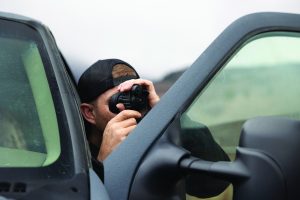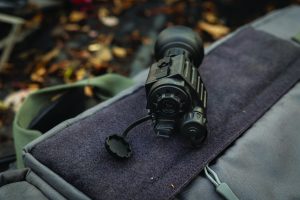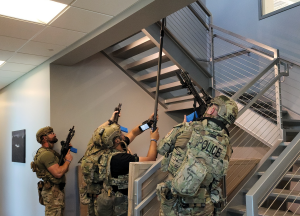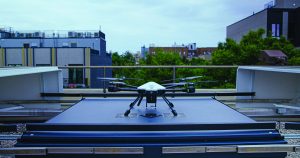Decision-making is a crucial aspect of police work, especially in high-stress situations. Without adequate tools, officers would be left to speculate about critical information rather than obtaining concrete facts that would allow them to adjust to the environment.
The thermal camera has become indispensable during police operations for revealing the unknown. “Law enforcement personnel face immense challenges daily,” said Steven Lemenov, director of marketing at Armasight. “They need tools that enhance their effectiveness and safety.”1 When pursuing a suspect in low-light conditions, in search and rescue operations, or even during tactical entries with visual obstructions like smoke, officers can use thermal imaging to detect heat signatures of others near them, giving them a clear advantage. “The ability to locate an individual in complete darkness, identify whether they are victim or perpetrator, and visually assess their threat level all while minimizing exposure to any potential threat is of paramount importance to police officers,” said Zistos Corporation (Zistos) Cofounder Bob Levine.2
Whether fixed or mobile or paired with high-definition and infrared capabilities, thermal cameras continue to evolve—and so has their use in policing.
Camera Versus Form
No matter their composition, a thermal imager can enhance human performance because it allows an individual to see things that they could not with the human eye.

Recognizing that there was a gap for a compact, high-resolution thermal monocular designed specifically for police use, Armasight released the Sidekick Thermal Monocular. Weighing under 250 grams, its compact size makes the imager ideal for handheld or helmet-mounted use. It is built with durable ULTEM construction, making it rugged and lightweight.
The Sidekick delivers smooth 640Hz operation and visual clarity due to Armasight’s Iron Wolf technology and thermal microbolometers (an instrument that measures temperature by detecting infrared radiation). With user-friendly controls, a high-definition OLED display, and one-touch video recording, the Sidekick 640 ensures officers can quickly capture and assess critical details in the field.

“The Sidekick Thermal Monocular excels in surveillance, search and rescue, and tactical entry, providing officers with a crucial advantage in challenging situations,” said Lemenov. The initial rollout of the thermal monocular began in spring 2024, and it has already been touted as a must-have tool for officers who need top performance on the go.
Zistos’ Dual-Mode Thermal Camera offers another way to see into areas that are inaccessible or potentially dangerous. The company has offered different versions of this product since the early 2000s and has continued to improve upon it based on consumer needs. It was originally designed to support location activity for search and rescue personnel looking for trapped individuals following a building collapse. “Handheld thermal imagers would not afford the same level of access and safety because the thermal imager is in the same environment as the operator,” said Levine. Zistos’ pole-mounted camera system was designed to provide a remote thermal imaging capability in a format that could be inserted into an inaccessible or dangerous area without causing harm to the inspector.

The dual-mode thermal camera is named as such because it uses two different camera technologies in the same housing. While thermal imaging is a great detection tool, other critical details may remain ambiguous without additional enhancements. “It’s for that reason that we married a high-resolution, infrared illuminated low-light camera along with the thermal sensor,” said Levine. With both camera options available, an officer can easily detect an individual in a low-light environment and toggle to the high-definition camera to make out other unknown information that a heat sensor would not provide. “These details may be critical to the decision-making required to mitigate a dangerous situation.”
The dual-mode camera is designed to mount on the end of a variety of telescoping poles or cables. Zistos’ pole lengths range from 2 to 30 feet, and their cables are able to extend to 150 feet. Each pole is configured with buttons that allow the end user to control and toggle the camera and turn on illuminators. These capabilities are also available through a Smart Display platform that can be mounted on the pole or worn by the operator. The images that the camera captures are wirelessly transmitted to the display, but they can also be tied into an external network.
What if a stationary camera isn’t the right fit for a specific situation, though? A thermal system that brings a watchful eye to the sky is Nightingale Security’s drone-in-a-box solution, Robotic Aerial Security (RAS). “Think of it as a thermal camera you can position anywhere and have at your disposal at any time,” said Jack Wu, cofounder and chief executive officer of Nightingale Security.3

The autonomous infrastructure is imperative to the operation of the solution. “Without having to touch the drone on every mission, the experience the operators have when using the drone is similar to using any other software,” said Wu. “They simply touch a button and know something is happening.” Once given waypoints, the drone flies, conducts overwatch, and lands and charges in the base station by itself. During its flight, the Blackbird drone is capturing images and video from a visible light camera as well as a FLIR thermal sensor that aids in night operations. It is also equipped with onboard object recognition, so when the camera shows an image of an individual or vehicle, if it’s in the auto-detection zone, the Blackbird will automatically alert the operator.
Although an agency can purchase one system, users find it even more beneficial when multiple units work as a team. The drones have a unique ability to communicate with each other, so, for instance, when one runs out of battery, it can summon another to take over a search.
Different than other drone-in-a-box solutions that rely on the cloud, the infrastructure acts as an edge-based computing platform, which means all the collected data will remain stored on the base station unless the customer wishes to share it. When the internet is disrupted during major crises (e.g., natural disasters or terrorist attacks), the drone will remain operable using a LAN local network.
Although previous adoption of RAS has been stilted by regulation, Wu explained that is no longer the case. With the Federal Aviation Administration’s Beyond Visual Line of Sight waiver, an agency is allowed to fly over the city without a visual observer.
Conclusion
The form of a device can change the way in which an operator chooses to utilize a camera, but they are ultimately similar solutions for the same problem. Police officers often have to assess situations that are difficult to access or contain hidden dangers.
“By seeing more, we are more likely to discover crimes that previously would have been unknown,” said Wu. During complex missions, enhanced imaging tools could be critical in the decision-making process to perform more successful outcomes.d
Notes:
1Steve Lemenov (director of marketing, Armasight), email interview, August 26, 2024.
2Bob Levine (cofounder, Zistos Corporation), phone interview, September 4, 2024.
3Jack Wu (cofounder/CEO, Nightingale Security), phone interview, September 3, 2024.
Source ListPlease click on the companies’ names to go to the companies’ websites. |
|


